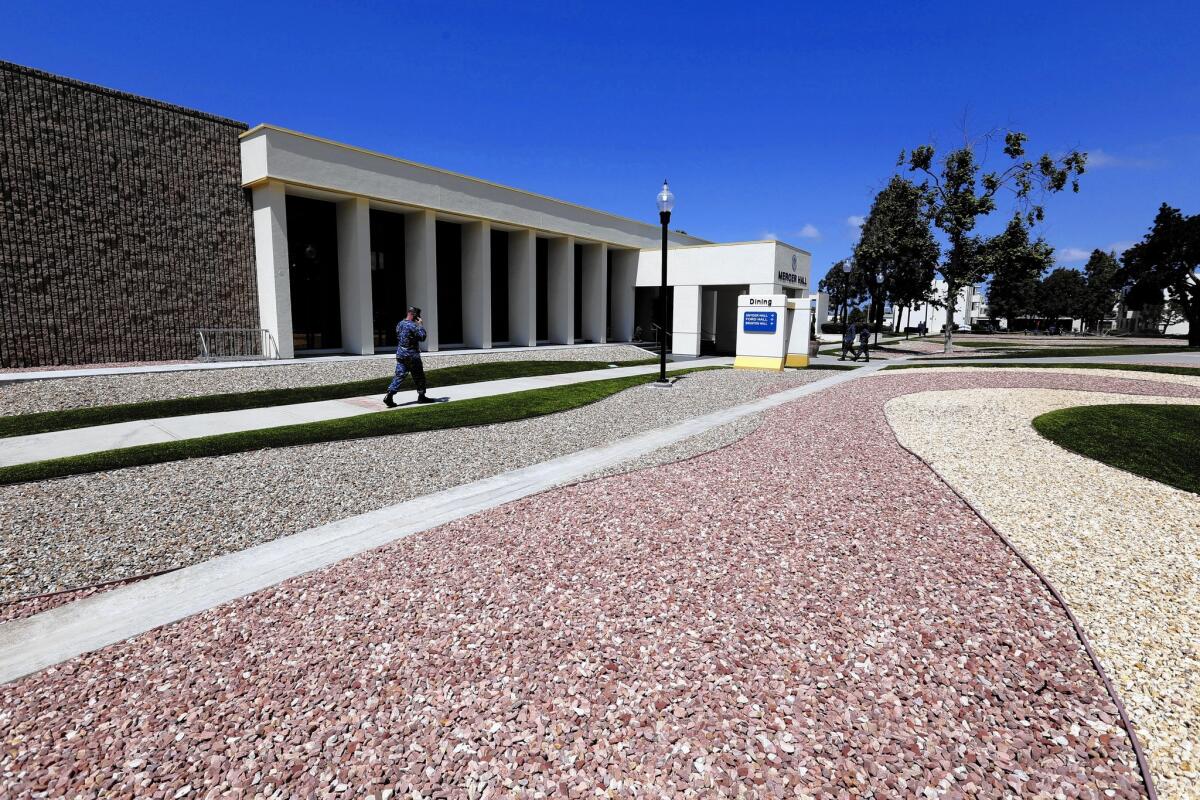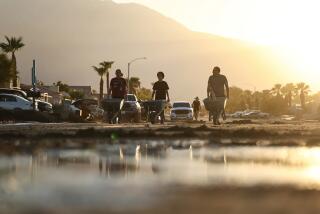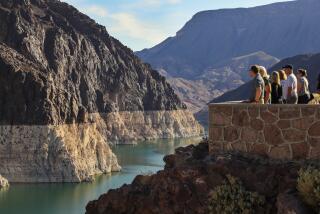Navy bases do their part to conserve water in California drought

Decorative rocks and artificial turf surround the Mercer Hall Galley at Naval Base San Diego. The Navy has replaced grass and plants to cut back on water use.
With its red and green synthetic turf, Destroyer Field at Surface Warrior Park is meant to reduce water use at Naval Base San Diego. The softball field needs occasionally to be combed, but not watered or mowed.
Destroyer Field represents the future in drought-stricken California, where grassy playing fields may seem a water-guzzling extravagance.
For the Navy, the future arrived in 2008 when then-President Bush signed an executive order mandating water reduction by federal agencies. The order was expanded by President Obama in March.
Since 2007, water use has been reduced by 23% at the nine bases in California and one in Nevada that are managed by an admiral and other officials at Navy Region Southwest, with headquarters on the San Diego waterfront.
At Naval Base San Diego, the most populous of the 10 bases, some 1.5 million square feet of landscaping was replaced by drought-resistant plants or artificial turf, or just allowed to turn brown.
But the state’s recent cutback orders — as numerous cities, including San Diego, have learned — do not take into account past conservation measures.
In response to the governor’s order, Rear Adm. Patrick Lorge, commander of Region Southwest, has ordered a reduction of 925 million gallons a year by 2020. He is not swayed by subordinates telling him it cannot be done.
“I don’t care what we’ve done in the past,” he said, “we still have a task to do better.”
Even with the 23% reduction since 2007, the Region Southwest bases use 3.7 billion gallons of potable water annually. The two largest consumers are Naval Base San Diego and Naval Base Coronado, each using about 550 million gallons; the smallest is Naval Support Activity Monterey at 20 million.
For Navy Region Southwest, the timing of the governor’s order is particularly challenging.
Under what the Department of Defense is calling a “Rebalance to the Pacific,” nearly all the region’s bases are looking at quick and dramatic growth. That means more ships, helicopters, sailors and civilian employees to San Diego, a bigger training facility for more SEALs in Coronado, a shore operations center and drones and Coast Guard assets to the base in Ventura County.
Also, a fighter squadron to the air station at Lemoore, new facilities at the Seal Beach weapons station to make it easier to load ammunition, an indoor marksmanship range on Coronado’s Silver Strand, and more, all of which will require water.
“I’m going to be bringing upwards of 20,000 people who will be stressing California’s already fragile water system,” Lorge said.
The growth is all to be accomplished, according to an official planning document, while continuing to “support water sustainability.”
Last week, the Governor’s Military Council, chaired by former congresswoman and State Department executive Ellen Tauscher, warned that the state should “help bases maintain reliable water supplies,” lest future expansion be curtailed.
“The importance of water security has been highlighted by Pentagon leaders amidst the ongoing drought in California,” the report said.
Destroyer Field, built in 2010, is the model for other fields, including the recently completed soccer and softball fields at North Island Naval Air Station. Low-flow shower heads, like those in a new seven-story barracks, are now required in all new construction. Bright green artificial turf replaced grass outside the nearby chow hall.
A video, including a no-nonsense message from the admiral, is being shot to make sure all ranks get the message. Planners are eyeing the remaining 1.5 million square feet of landscaping to see how much can be removed or modified. Landscape irrigation consumes 18% of the bases’ water use.
“We are currently identifying potential projects, which we expect will include many landscape projects,” said Bernard Lindsey, the region’s energy manager. Spot meters are also being installed to detect leaks or over use, in real-time.
Naval Base San Diego gets water from the city of San Diego and the Chula Vista-based Sweetwater Authority, with no discount for being military.
When San Diego Mayor Kevin Faulconer summoned officials from the city’s 10 biggest governmental water consumers for a meeting at City Hall, the Navy was on the list, just behind the city of San Diego and ahead of UC San Diego, Caltrans and the San Diego school district.
“We’re part of the community, we can’t be an island,” Lorge said. “We need to lace on our bootstraps and take a tug on the oar.”
Twitter: @latsandiego
More to Read
Start your day right
Sign up for Essential California for news, features and recommendations from the L.A. Times and beyond in your inbox six days a week.
You may occasionally receive promotional content from the Los Angeles Times.






